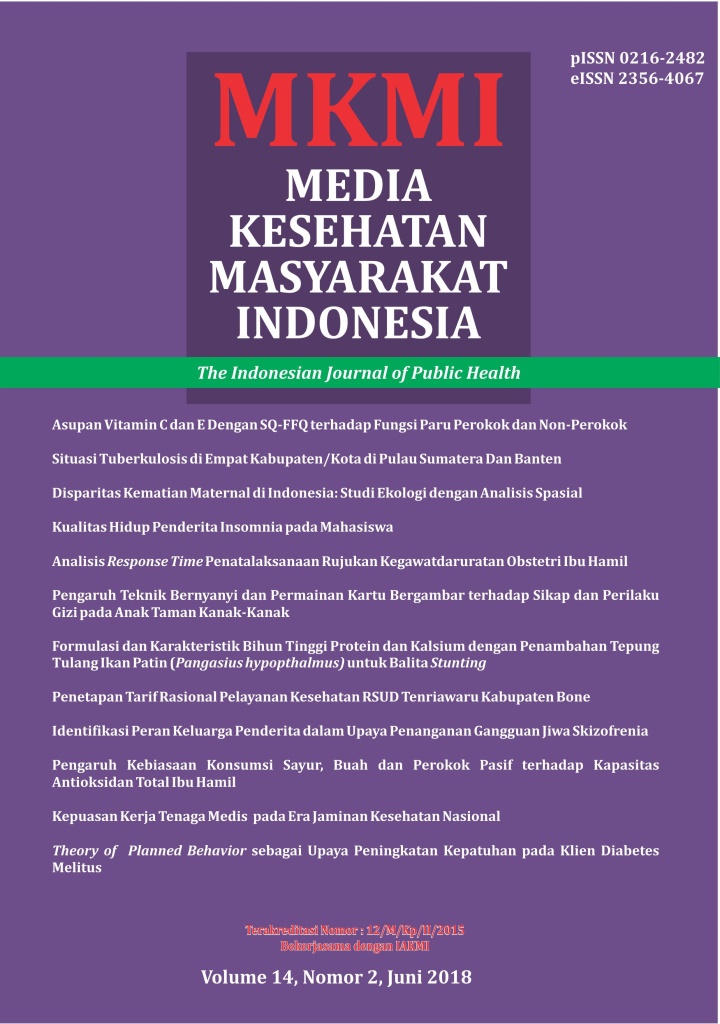Situasi Tuberkulosis di Empat Kabupaten Kota di Pulau Sumatera dan Banten
Abstract
Situational and costing analysis of TB burden in district level is rarely conducted eventhough its importances
in planning, budgeting, costing and evaluating TB care services. Study conducted in Tangerang District,
Tanggamus District, Metro City and Dumai City with mixed method approach. Quantitative data collection used
secondary data to current situation and cost of TB programme. Meanwhile qualitative data collection through
round table discussion with stakeholders. TB incidence and success rate of medication were highest in Tanggamus
District. Metro City had the highest incidence and cure rate. The highest TB costing were allocated in Tangerang
District, Rp. 6.737.303.630,-. Within all regions, costing washighly allocated for drug. Problems in TB control
were unstandardized TB care, underestimated data, lack of case finding, limited man power for TB programme,
lack of CSR contribution, lack of promotive and preventive activity, bad stigma, difficulty in monitoring and evaluation
and cantack survey, and specific issues among low income and worker population. TB control among these
four regions were not optimized, the we recommend to developing the policy in district level as an umbrella to
strengthen the budget and cross-sectoralcollaboration.
References
WHO, Global Tuberculosis Report 2017. 2017, Jenewa: WHO.
Pusdatin, Tuberkulosis: Temukan Obati Sampai Sembuh. 2016: Jakarta.
Collins, D., et al., Costs faced by multi-drug resistant tuberculosis patients during diagnosis and treatment. Report from a pilot study in Ethiopia. Cambridge, MA, USA: TB CARE I–Management Sciences for Health, 2013.
Subdit TB, Pembiayaan AIDS, TB dan Malaria (ATM) Menyongsong BPJS 2014. Warta Tuberkulosis Indonesia, 2013. 23(April): p. 1.
USAID. TB Care I Costing Tools. . 2018 [cited 2018; Available from: https://www.challengetb.org/publications/tools/costing/TB_CARE_I_Costing_Tools.pdf.
Shargie, E.B., O. Mørkve, and B. Lindtjørn, Tuberculosis case-finding through a village outreach programme in a rural setting in southern Ethiopia: community randomized trial. Bulletin of the World Health Organization, 2006. 84: p. 112-119.
Muniyandi, M., et al., Socio-economic dimensions of tuberculosis control: review of studies over two decades from Tuberculosis Research Center. Journal of Communicable Diseases, 2006. 38(3): p. 204.
Muniyandi, M. and R. Ramachandran, Socioeconomic inequalities of tuberculosis in India. Expert opinion on pharmacotherapy, 2008. 9(10): p. 1623-1628.
Boccia, D., et al., The association between household socioeconomic position and prevalent tuberculosis in Zambia: a case-control study. PloS one, 2011. 6(6): p. e20824.
Abebe, Y., et al., HIV prevalence in 72 000 urban and rural male army recruits, Ethiopia. Aids, 2003. 17(12): p. 1835-1840.
Ahmed Yassin, M., et al., HIV and tuberculosis coinfection in the southern region of Ethiopia: a prospective epidemiological study. Scandinavian journal of infectious diseases, 2004. 36(9): p. 670-673.
Quy, H.T., et al., Public-private mix for improved TB control in Ho Chi Minh City, Vietnam: an assessment of its impact on case detection. The International Journal of Tuberculosis and Lung Disease, 2003. 7(5): p. 464-471.
Dhingra, V. and S. Khan, A sociological study on stigma among TB patients in Delhi. Indian Journal of Tuberculosis, 2010. 57(1).
Oberoi, S., et al., Understanding health seeking behavior. Journal of family medicine and primary care, 2016. 5(2): p. 463.
Eang, M.T., et al., Early detection of tuberculosis through community-based active case finding in Cambodia. BMC Public Health, 2012. 12(1): p. 469.
Syafar, M. and N.J. Abna, Kemitraan Pemerintah dengan Muslimat NU (NGO) dalam Pengendalian Tuberkulosis Paru. Media Kesehatan Masyarakat Indonesia, 2017. 13(3): p. 281-288.
Van Meter, D.S. and C.E. Van Horn, The policy implementation process: A conceptual framework. Administration & Society, 1975. 6(4): p. 445-488.
Authors
Copyright (c) 2018 Ajeng Tias Endarti

This work is licensed under a Creative Commons Attribution-NonCommercial-ShareAlike 4.0 International License.
Authors retain copyright and grant the journal right of first publication with the work simultaneously licensed under a Creative Commons Atribusi-NonKomersial-BerbagiSerupa 4.0 Internasional License that allows others to share the work with an acknowledgement of the work's authorship and initial publication in this journal.
Copyright encompasses rights to reproduce and deliver the article in all form and media, including reprints, photographs, microfilms and any other similar reproductions, as well as translations. The reproduction of any part of this journal, its storage in databases and its transmission by any form or media, such as electronic, electrostatic and mechanical copies, photocopies, recordings, magnetic media, etc.
All articles published Open Access are free for everyone to read and download. Under the CC-BY-NC-SA license, authors retain ownership of the copyright for their article, but authors grant others permission to use the content of publications in Media Kesehatan Masyarakat Indonesia Universitas Hasanuddin in whole or in part provided that the original work is properly cited. Users (redistributors) of Media Kesehatan Masyarakat Indonesia Universitas Hasanuddin are required to cite the original source, including the author's names, Media Kesehatan Masyarakat Indonesia Universitas Hasanuddin as the initial source of publication, year of publication, and volume number.
Media Kesehatan Masyarakat Indonesia Universitas Hasanuddin is licensed under Creative Commons Atribusi-NonKomersial-BerbagiSerupa 4.0 Internasional.


